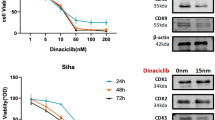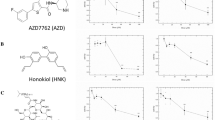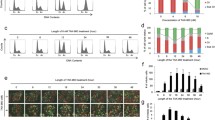Summary
This study examined the role of PI3K/Akt pathway in radiosensitization of DNA damage of cervical carcinoma cells. The 50% inhibition concentration (IC50) of cisplatin and docetaxel in HeLa cells was detected by Mono-nuclear cell direct cytotoxicity assay (MTT) in vitro. HeLa cells were treated by cisplatin/docetaxel of 10 percent of IC20 alone or combined with LY294002 for 24 h, and then radiated by different doses of X-ray. The cell survival ratio was obtained by means of clone formation. One-hit multi-target model was fitted to the cell survival curve to calculate dose quasithreshold (Dq), mean lethal dose (D0), 2Gy survival fraction (SF2) and sensitization enhancement ratio (SER). The pAkt and total Akt expression was detected by Western blotting and DNA damage by neutro-comet electrophoresis. The HeLa cells were randomly divided into 7 groups in terms of different treatments: Control; radiation treatment (RT) group; LY294002+RT group; cisplatin+RT group; docetaxel+RT group; LY294002+cisplatin+RT group; LY294002+docetaxel+RT group. The apoptosis ratio of each group was measured by flow cytometry. The results showed that docetaxel and cisplatin significantly enhanced the phosphorylation of Akt in radiation-treated HeLa cells. The Dq, D0 and SF2 in LY294002-contained groups were lower than those in docetaxel or cisplatin+RT group. The SER in the LY294002+docetaxel+RT group was 1.35 times that of the docetaxel+RT group, and that in the LY294002+cisplatin+RT group 1.26 times that of the cisplatin+RT group. The Comet electrophoresis showed that tail distance in the LY294002+cisplatin+RT group or LY294002+docetaxel+ RT group was longer than in the cisplatin+RT group or docetaxel+RT group. The apoptosis ratio in the LY294002+cisplatin+RT group or LY294002+docetaxel +RT group was higher than in the cisplatin+RT group or docetaxel+RT group. It was concluded that inhibiting PI3K/Akt pathway can increase the effect of docetaxel and cisplatin on the radiosensitivity of HeLa cells and DNA damage resulted from radiation.
Similar content being viewed by others
References
Jin ZH, Kurosu T, Yamaguchi M, et al. Hematopoietic cytokines enhance Chk1-dependent G2/M checkpoint activation by etoposide through the Akt/GSK3 pathway to inhibit apoptosis. Oncogene, 2005,24(12):1973–1981
Cheng JQ, Lindsley CW, Cheng GZ, et al. The Akt/PKB pathway: molecular target for cancer drug discovery. Oncogene, 2005,24(50):7482–7492
Opel D, Westhoff MA, Bender A, et al. Phosphatidylinositol 3-kinase inhibition broadly sensitizes glioblastoma cells to death receptor- and drug-induced apoptosis. Cancer Res, 2008,68(15):6271–6280
Okumura E, Fukuhara T, Yoshida H, et al. Akt inhibits Myt1 in the signalling pathway that leads to meiotic G2/M-phase transition. Nat Cell Biol, 2002,4(2): 111–116
Han R. The application of quantitative analysis of drugs’synergetic and antagonism effect. In: Zhou TC, Han R, Xu B. Chemoprevention and pharmacotherapy of tumor. Beijing: Peking Union Medical College Press, 1991:315–320
Tan J, Hallahan DE. Growth factor-independent activation of protein kinase B contributes to the inherent resistance of vascular endothelium to radiation-induced apoptotic response. Cancer Res, 2003, 63(22):7663–7667
Kandel ES, Skeen J, Majewski N, et al. Activation of Akt/protein kinase B overcomes a G(2)/m cell cycle checkpoint induced by DNA damage. Mol Cell Biol, 2002,22(22):7831–7841
Riesterer O, Tenzer A, Zingg D, et al. Novel radiosensitizers for locally advanced epithelial tumors: inhibition of the PI3K/Akt survival pathway in tumor cells and in tumor-associated endothelial cells as a novel treatment strategy? Int J Radiat Oncol Biol Phys, 2004,58(2): 361–368
Cordes N, van Beuningen D. Arrest of human lung fibroblasts in G2 phase after irradiation is regulated by converging phosphatidylinositol-3 kinase and beta1-integrin signaling in vitro. Int J Radiat Oncol Biol Phys, 2004,58(2):453–462
Kim IA, Bae SS, Fernandes A, et al. Selective inhibition of Ras, phosphoinositide 3 kinase, and Akt isoforms increases the radiosensitivity of human carcinoma cell lines. Cancer Res, 2005,65(17):7902–7910
Gupta AK, Cerniglia GJ, Mick R, et al. Radiation sensitization of human cancer cells in vivo by inhibiting the activity of PI3K using LY294002. Int J Radiat Oncol Biol Phys, 2003,56(3):846–853
Lee DF, Kuo HP, Chen CT, et al. IKKbeta suppression of TSC1 function links the mTOR pathway with insulin resistance. Int J Mol Med, 2008,22(5):633–638
Sauer S, Bruno L, Hertweck A, et al. T cell receptor signaling controls Foxp3 expression via PI3K, Akt, and mTOR. Proc Natl Acad Sci U S A, 2008,105(22): 7797–7802
Steinberg R, Harari OA, Lidington EA, et al. A protein kinase Cepsilon-anti-apoptotic kinase signaling complex protects human vascular endothelial cells against apoptosis through induction of Bcl-2. J Biol Chem, 2007,282(44):32288–32297
Aziz MH, Nihal M, Fu VX, et al. Resveratrol-caused apoptosis of human prostate carcinoma LNCaP cells is mediated via modulation of phosphatidylinositol 3′-kinase/Akt pathway and Bcl-2 family proteins. Mol Cancer Ther, 2006,5(5):1335–1341
Clark AS, West K, Streicher S, et al. Constitutive and inducible Akt activity promotes resistance to chemotherapy, trastuzumab, or tamoxifen in breast cancer cells. Mol Cancer Ther, 2002,1(9):707–717
Canguilhem B, Pradines A, Baudouin C, et al. RhoB protects human keratinocytes from UVB-induced apoptosis through epidermal growth factor receptor signaling. J Biol Chem, 2005,280(52):43257–43263
Shen Y, Mi FS. Tumor Radiation Biology. Beijing: Chinese Medicine Science Press, 2002,52–78
Yin WB, Gu XZ, Xu GZ, et al. Radiation Oncology. The 4th edition. Beijing: Chinese Xiehe Medical University Press, 2008,232–239
Fairbairn DW, Olive PL, O’Neill KL. The comet assay: a comprehensive review. Mutat Res, 1995,339(1):37–59
Singh NP, Stephens RE. Microgel electrophoresis: sensitivity, mechanisms, and DNA electrostretching. Mutat Res, 1997,383(2):167–175
Okayasu R, Takakura K, Poole S, et al. Radiosensitization of normal human cells by LY294002: Cell killing and the rejoining of DNA and interphase chromosome breaks. J Radiat Res (Tokyo), 2003,44(4):329–333
Friedmann B, Caplin M, Hartley JA, et al. Modulation of DNA repair in vitro after treatment with chemotherapeutic agents by the epidermal growth factor receptor inhibitor gefitinib (ZD1839). Clin Cancer Res, 2004,10(19): 6476–6486
Author information
Authors and Affiliations
Corresponding author
Additional information
This project was supported by grants from the Hubei Province Natural Sciences Foundation (No.2008cdb133) and Science Foundation for The Youth Scholars of Ministry of Education of China (No.200804871034).
Rights and permissions
About this article
Cite this article
Xia, S., Yu, S., Fu, Q. et al. Inhibiting PI3K/Akt pathway increases DNA damage of cervical carcinoma HeLa cells by drug radiosensitization. J. Huazhong Univ. Sci. Technol. [Med. Sci.] 30, 360–364 (2010). https://doi.org/10.1007/s11596-010-0357-0
Received:
Published:
Issue Date:
DOI: https://doi.org/10.1007/s11596-010-0357-0




